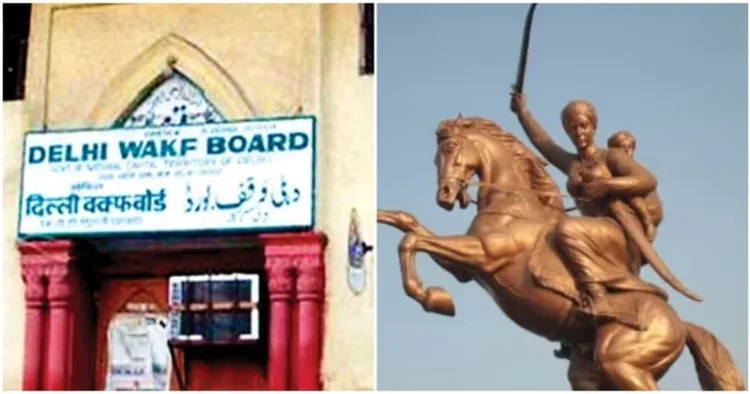The statue of Rani Lakshmibai, originally located at the Jhandewalan intersection, is being relocated due to traffic disturbances in the area. This raised the question of where the statue should be moved. One of the proposed sites was Government land near the Shahi Idgah, but this led to strong opposition from the Muslim community. The Waqf Board, along with its affiliated institutions, opposed the idea, arguing that this Government park, which they had named ‘Shahi Idgah Park,’ should not host the statue of Rani Lakshmibai, the famous martyr of Jhansi. They claimed that the park was their property and accused the administration of encroaching on it.

The Waqf Board’s argument was based on a 1970 gazette notification, which declared the Shahi Eidgah Park to be waqf property. They pointed out that this land, built during the Mughal era, was historically used for offering “Namaz.” The Waqf Board also emphasised the significance of the site, mentioning that the large complex could accommodate over 50,000 people for prayers at a time.
However, the Delhi High Court dismissed these claims. The court referred to a previous High Court order, which clarified that the parks and open spaces around Shahi Idgah were actually owned and maintained by the Delhi Development Authority (DDA). These areas were managed under the DDA’s Horticulture Division II. The court also noted that the Shahi Idgah Waqf Managing Committee’s argument lacked solid grounds and that no compelling reason had been presented to support their objection.
In its ruling, the High Court firmly stated that the Waqf Committee had no right to oppose the maintenance of the park by the DDA, nor did they have the legal standing to prevent the installation of Rani Lakshmibai’s statue. On September 25, 2024, the Delhi High Court rejected the plea from the Muslim community that sought to stop the statue’s relocation to Shahi Idgah Park in Sadar Bazar. Justice Dharmesh, who delivered the ruling, dismissed the opposition, stating that the argument against the installation was baseless and had no legal foundation. The court also reprimanded the lawyer representing the Muslim community for presenting weak and unfounded arguments.
Following the court’s decision, DDA officials promptly arrived at Shahi Idgah to take possession of the parkland for the purpose of installing the statue of Rani Lakshmibai. A significant police presence was deployed to ensure the smooth execution of this task and to prevent any potential unrest during the process.
Despite the court’s ruling, several political figures voiced their opposition to the decision. A prominent name in the opposition was Aam Aadmi Party (AAP) National Spokesperson Sanjay Singh. In a public statement, Singh falsely claimed that Rani Lakshmibai’s statue was going to be removed from its current location in Delhi, misleading the public. His statement created confusion, as in reality, the statue was only being shifted to a new location, not removed altogether. Singh further warned that this issue would be used as a political tool in the upcoming Haryana Assembly elections, stating, “Now we will raise this issue everywhere,” signalling his intent to exploit the controversy for political gain against the ruling Bharatiya Janata Party (BJP). Critics argued that Singh’s statements were aimed at stirring public sentiment and disrupting peace.
Another AAP leader, the Mayor of the Municipal Corporation of Delhi (MCD), also intervened by writing a letter to the authorities, urging them not to relocate the statue from its original site. This move fueled speculation that the Aam Aadmi Party was more concerned about appealing to the Muslim minority vote bank than respecting the legacy of Rani Lakshmibai. Observers suggested that while the party did not necessarily oppose the statue’s relocation, they were troubled by the specific site chosen for its new placement.
Meanwhile, social media was flooded with videos of a woman who called on the Muslim community to gather and resist the installation of the statue near the mosque. In these videos, she urged people to protect their mosque and objected to the development authorities’ plans. She was seen confronting on-duty police officers, accusing them of interfering with religious space and speaking in a provocative manner. When her attempts to incite public opposition appeared unsuccessful, she played the victim card, calling on local Muslims and other Muslim organisations to rally at the site and oppose the project, drawing comparisons to the AIMIM’s ‘Chalo Mumbai’ rally.
As tensions grew, Muslim organisations announced plans for a protest on September 26, 2024, at 4:00 pm at the Eidgah grounds. This same ground has been used for large gatherings, including during the protests against the Citizenship Amendment Act (CAA), and is known for hosting large religious events. In anticipation of potential unrest, the administration deployed a large contingent of police and CRPF personnel to the area. Additionally, Section 144, which prohibits large gatherings in sensitive areas, was imposed to maintain public order.
This situation highlights a broader concern regarding the Waqf Board and its affiliated institutions’ attempts to claim Government and private lands as their own. The conflict underscores the necessity for an amendment to the Waqf Board Act to prevent such encroachments on public property. When even Government land is at risk of such claims, it raises questions about the protection of private citizens’ rights and property from similar disputes in the future.



















Comments